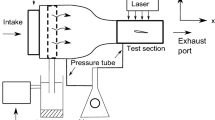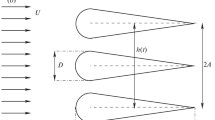Abstract
Experimental measurements were conducted on a plunging Eppler 361 Gurney flapped airfoil to study wake structure and dynamic stall phenomenon in the wake. The heights of Gurney flap were 2.6 and 3.3% chord. All oscillation data were taken at the plunging amplitude of 6 cm and Reynolds number 1.5 × 105. Special attention was focused on the temporal progressions of the plunging wake for the range of initial angle of attack (0° and 12°) in prior and post-stall flow conditions. The velocity in the wake was measured by hot-wire anemometry. Surface pressure measurements, as supplementary data, were also carried out to look into the link between the boundary-layer flow and the shedding vortical flow. It was found that the hysteresis is detected between the plunging wake in the upstroke and down-stroke. The shape and width of the wake hysteresis loops strongly depend on the initial angle of attack and vertical positions of the sensor. At prior static-stall angle of attack, positive camber effects of flapped airfoil shifted wake profiles downward and more velocity deficits were detected. In the post-stall conditions the hysteresis loop widths for lower-than-centerline vertical positions were remarkably more than counterpart upper positions. The energetic dynamic stall vortex shedding was found to be main responsible for large hysteresis and velocity deficit at these positions. Furthermore, the extent and strength of the stalled wake or flow separation were found to increase for the flapped case which results in a significant increase in the hysteresis loop widths.
Similar content being viewed by others
References
Seling, M.S., and Guglielmo, J.J., “High-lift Low Reynolds Number Airfoil Design,” Journal of aircraft 34(1):72–79 (1997).
Liebeck, R.H., “Design of Subsonic Airfoils for High Lift,” Journal of Aircraft 15(9):547–551 (1978).
Jang, C.S., Ross, J.C., and Cummings, R.M., “Numerical Investigation of an Airfoil with a Gurney Flap,” Aircraft Design 12:75–88 (1998).
Myose, R., Papadakis, M., and Heron, I., “Gurney Flap Experiments on Airfoils, Wings, and Reflection Plane Model,” Journal of Aircraft 35(2):205–211 (1998).
Giguère, P., Dumas, G., and Lemay, J., “Gurney Flap Scaling for Optimum Lift-to-drag Ratio,” AIAA Journal 35(12):1888–1890 (1997).
Li, Y., Wang, J., and Zhang, P., “Effects of Gurney Flaps on a NACA 0012 Airfoil,” Flow Turbulence and Combustion 58(1):27–39 (2002).
Liu, T.S., and Montefort, J., “Thin Airfoil Theoretical Interpretation for Gurney Flap Lift Enhancement,” Journal of Aircraft 44(2):557–571 (2007).
Troolin, D.R., Longmire, E.K., and Lai, W.T., “Time Resolved PIV Analysis of Flow Over a NACA0015 Airfoil with Gurney Flap,” Experiments in Fluids 41(2):241–254 (2005).
Lee, T., and Gerontakos, P., “Investigation of Flow over an Oscillating Airfoil,” Journal of Fluid Mechanics 512:313–341 (2004).
Gerontakos, P., and Lee, T., “Oscillating Wing Loadings with Trailing Edge Strips,” Journal of Aircraft 43(2):428–435 (2006).
Gerontakos, P., and Lee, T., “Particle Image Velocimetry Investigation of Flow over Unsteady Airfoil with Trailing-edge Strip,” Experiments in Fluids 44(4):539–555 (2008).
Soltani, M.R., Seddigh, M., and Rasi Marzabadi, F., “Comparison of Pitching and Plunging Effects on the Surface Pressure Variation of a Wind Turbine Blade Section,” Journal of Wind Energy 12(3):213–239 (2009).
Thomas, G.B., Roy, D.M., and John, H.L., Mechanical Measurements, Fifth Edition, Addison-Wesley, New York, NY (1993).
Lee, T., and Ko, L.S., “PIV Investigation of Flowfield Behind Perforated Gurney-type Flaps,” Experiments in Fluids 45(5):1005–1019 (2009).
Ajalli, F., Mani, M., and Soltani, M., “An Experimental Investigation of Pressure Distribution around a Heaving Airfoil,” The 5th International Conference on heat Transfer, Fluid Mechanic and Thermodynamics, South Africa, 2007.
Ericsson, L.E., and Reding, J.P., “Fluid mechanics of dynamic stall”, Part I. Unsteady flow concepts,” Journal of Fluids and Structures 2:1–33 (1988).
Gordon Leishman, J., Principles of Helicopter Aerodynamics, Second Edition, Cambridge University Press, Cambridge, UK (2006).
Lee, L., and Lee, T., “Effect of Gurney Flap on Unsteady Wake Vortex,” Journal of aircraft 44(4):1398–1401 (2007).
Author information
Authors and Affiliations
Corresponding author
Rights and permissions
About this article
Cite this article
Ajalli, F., Mani, M. & Tadjfar, M. Plunging wake analysis of an airfoil equipped with a Gurney flap. Exp Tech 39, 48–60 (2015). https://doi.org/10.1111/j.1747-1567.2012.00864.x
Received:
Accepted:
Published:
Issue Date:
DOI: https://doi.org/10.1111/j.1747-1567.2012.00864.x




